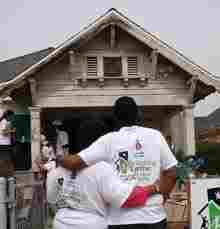Archive for the ‘Roofs’ Category
Oldest US Childrens Home Gets New Roof and Repairs

The Carrie-Steele Pitts Home in Atlanta received a heartfelt birthday gift for the children’s home 123rd year anniversary. On October 15, 2011 more than 100 volunteers installed new roofs, painted, made repairs to electricity, carpentry and plumbing for the residential apartments and spruced up the landscaping.
Volunteers
The Rebuilding Together project volunteers; CNA global business insurer, NRCA National Roofing Contractors Association, Land Improvement Contractors of America and the Georgia chapter of Mechanical Contractors Association of America were on board for a day of major repairs and renovations. Chris Grundy, television DIY star, and radio personality James Carey were also there to help out.
Over 20,000 Children Passed Through This Home
The Carrie-Steele Pitts home is the oldest child care home in the United States. The home has provided for over 20,000 of Atlanta’s children and young adults with all inclusive care, education and shelter.
CNN and Rebuilding Together
“CNA and all of our construction association partners are proud to provide the elbow grease for these rebuild day renovations,” said John Tatum, vice president – Construction, CNA. “The repairing of damaged roofing, replacing windows and doors, installing new bathroom facilities, flooring and interior walls, will serve as a wonderful commemoration for all of the work and the strong impact CSPH has had on the children of Atlanta.”
Rebuilding Together is a non-profit organization. With a network of over 200 affiliates they provide free rehabilitation and critical repairs to the homes of low income Americans.
Fire Safety and Roofs
Most roofing materials are fire-rated by standards writing organizations. You may have noticed a UL on the roofing material for Underwriters Laboratory, National Fire Protection Association (NFPA) or the American Society for Testing Materials (ASTM).
Class
Class “A”, being the most fire resistant, is able to withstand severe exposure to fire originating outside the building. Class “B”, is able to withstand moderate exposure to fire originating outside the building. Class “C”, is able to withstand light exposure to fire originating outside the building. And unrated, which is the most vulnerable roof.
To determine the fire ratings, roofing material is set on fire in a laboratory. A burning piece of wood is set on top of the testing material and then set on top of a roof structure mock up.
Fire Rating
- Class A roof coverings include composition shingles, clay tiles, slate, concrete, steel or copper roofs. Ceramic and concrete roofs are heavy and weaken building structures creating a higher risk for collapse.
- Aluminum roofs can have a Class A if installed with a fire resistant underlying material.
- A fire retardant treated shake roof has a Class B rating, but can qualify as Class A if a fire resistant material is used underneath the shakes. If you cannot find the fire rated documentation from the manufacturer, assume your wood shake is unrated.
- Recycled rubber and plastic roofing shingles and shakes usually have a fire rating of Class C. Manufacturers can increase the fire rating if a fire resistant underlayment is used.
- Green roofs, there are no current fire ratings for these plant covered roofs. Naturally fire retardant sedums and succulents do not pose a risk to spreading the fire. If you use natural grasses on your roof, you can assume they are the same risk as grasses in your yard. If the plants are dry, they will burn and potentially spread the flames.
- Thatch roofs have been used for literally thousands of years. Fire danger is reduced by using aluminum barrier foil, fire retardant spray and non-combustible underlayment.
Check the Packaging
Check the fire rating class on the packaging of the roofing materials you are purchasing. Ask if there are ways to increase the fire rating, such as special underlayments or fire retardant sprays. Also check with your homeowners insurance and make sure the roofing material you are considering will be covered under your current policy.
History of Roofs
As long as man has been around there have been a need for shelter and protection from the elements. Throughout history roofs have been made from available resources. Cavemen covered their structures with sod roofs covered with earth and plants. These early shelters provided good insulation unfortunately they were not vermin or waterproof.
Research has shown the first known glazed clay roof tile was used in China 5,000 years ago. Greece and Babylon used flat earthenware roof tiles between 4,000 and 5,000 years ago. The Romans brought variations of the Greek clay tiles to England as early as 100 BC.
Around 735 AD thatched roofs were developed and used. Wood shingles were introduced 300 years later. In an effort to prevent spreading fires, the 12th century King John issued a law in London that citizens were to replace their thatch and reed roof coverings with clay tiles.
Industrial production of clay roofing tiles began in the 19th century. One hundred years later concrete roof tiles were first used, when first introduced in the early 1900’s the practice was to add a pigment to resemble clay roofing tiles.
In the early 1970’s Germany began developing and marketing the first green roof systems. Asphalt also became available in the 19th century. It quickly became a popular product due to the ability to mass produce it at a reasonable cost.
Most of the changes in roofing materials have developed in the last 200 years. Although people generally still use the most available materials for the region. Wood and metal are used in the southern part of North America, slate in the northeast, wood in the Midwest and tile in the southwestern part of North America.
Now we are seeing technological advances in glass, polymer and smog absorbing tiles. Who knows what will be common roof coverings in our near future. With a trend in energy savings we will undoubtedly see a emergence in earth friendly roof top materials.
Nashua Fire Department Re-Usable Roof
Nashua New Hampshire, high school students design and build a re-usable roof for the Nashua  Fire Department at their fire rescue training facility at the city landfill.
Fire Department at their fire rescue training facility at the city landfill.
Nashua high school administrators approached the fire department with an offer to let the students work on the fire department building. The students designed a reusable 48 square foot box that fits inside one of the four hatches on the gabled roof.
Five students in the building construction class showed up this Saturday at Four Hills landfill and installed shingles on the roof they had moved from their school. A crane will set the roof on top of the 3 story concrete building later this month.
The structure is used for training for Nashua and other area firefighters who regularly set the building on fire.
The new design’s replaceable openings can be changed out, so when the firefighters ventilate for smoke and gas by axing their way through the ceiling, only the reusable boxes will need to be replaced.
Replacing the roof has cost the city $10,000 to $15,000; the new design will cost approximately $3,500 to rent the crane and materials.
Renting School Rooftops

Image via Wikipedia
Tucson Electric Power Company may have one option for the budget crisis in our public schools. They are offering the “Bright Roofs Program” to the school systems in Tucson, Arizona. TEP is proposing to lease school and other public building rooftops to develop new grid connected solar panel systems.
The goal is to help participating schools save money on energy costs and put the savings back into the classrooms. By allowing the TEP to rent the rooftops for the solar panels, the schools will be able to generate additional money. One high school with a 20,000 square foot flat roof can generate enough electricity for 170 homes. The solar arrays can be installed without making holes in the roof, thereby decreasing any chance of roof damage.
Kohl’s department store is participating in a similar program where SunEdison pays for the solar panels, installation and upkeep and then sells the electricity generated back to kohl’s at or below cost of grid power.
The Obama administration is providing millions of dollars in stimulus payments for “Modernization, energy efficiency and the use of alternative sources of energy“. If the school districts and solar or power companies can participate to find ways to take advantage of the stimulus and tax dollars available for “green roofing” it appears it would be mutually beneficial.
Our education system is in trouble, with budget cuts and increase in population, it’s clear we need to find alternative methods to keep our school doors open. By using the resources the schools already have, such as flat rooftops available to lease to the power companies for solar grid systems. The schools can save money on energy costs, reduce their carbon output, generate a few dollars to go back into the classroom, offer clean energy for the neighborhoods, and provide a unique learning environment for the students.
Recycled Roof Shingles Paving the Way
Several states are recycling roofing shingles to help pave the roads. Using asphalt mixed with recycled roofing shingles cuts the waste in landfills and saves paving contractors’ money. 27,000 pounds of carbon dioxide greenhouse gas emissions are avoided on a typical paving project by using 5% shingles in place of virgin asphalt binder.
Asphalt shingles constitute nearly 2/3 of the roofing markets. A roof replacement can generate 2-5 pounds per square foot of waste. 240,000 tons of asphalt shingles are sent to Colorado landfills each year and 276,000 tons of roofing shingles are dumped into Missouri landfills each year. EPA estimates 7-10 million tons of shingle tear off waste and installation scrap and with more than 60 manufacturing plants across US generating another 750,000 to 1 million tons of manufacturing shingle scrap waste per year.
With the “Roofs to Roads Colorado program” Denver based contractor Brannan Sand and Gravel and Erie based contractor Asphalt Specialties, are using recycled shingles to replace part of the need for new materials for paving roads. Boulder County plans to use shingles to pave part of Cherryvale Road later this summer and several other projects for 2011.
Currently, almost all recycled asphalt shingles are used in paving. 16 states currently have shingle recycling operations and/or state DOT specs allowing recycled shingles, FL, GA, IL, IN, IA, ME, MD, MA, MI, MN, NH, NJ, OH, PA, WA. Check with your local roofers or the EPA for a list of recycling facilities.
Contractor Rescues Cats on Rooftop
In a home near Seattle Washington, 2 cats were stuck on a neighbors steeply graded roof for 3 days, afraid to come down. People with ladders and water hoses were unsuccessful at retrieving the frightened cats.
Unable to find a local company specializing in animal rescue from steep roofs, the kitty’s owners called Norm Hoglund of Jorve Roofing. Mr. Hoglund set up a ladder to the highest part of the roof and within 5 minutes had retrieved both of the cats.
Onlookers were amazed at the ease of which he descended the ladder with one arm while holding a cat with the other. When the cat owners asked how much they owed him, Mr. Hoglund said there will be no charge, and that Jorve Roofing was glad to help.
Rooftop Venues
A new trend in the Unites States is using rooftops for more space at bars and restaurants. In parts of Washington DC, roof decks are becoming a real option for outdoor seating, for eating, and drinking. Also being able to seat and serve patrons who smoke.
The extra roof space brings in new customers who enjoy some of the breathtaking sights from the rooftop, for some restaurants touting as much as 80% of its business’s revenue. At least 30 new venues have recently opened in the DC area, according to a consumer review website Yelp.com.
One of the drawbacks is the noise complaints made by neighbors. The constant noise from the rooftop visitors can be bothersome. Communities are rightfully concerned about their right to a quiet environment. Some restaurant and bar owners are limiting the rooftop hours to be courteous to neighbors.
800 Year Old Roof Finial Found Beside Thames
A piece of muddy terracotta found on banks of the Thames River in England turned out to be a medieval roof finial. The animal shaped finial is believed to be up to 800 years old, some say it is an elephant, others say owl. The finial is expected to provide rare insight into the roofs of medieval London. Little is known since a fire destroyed much of the area’s landscape in 1666.
The ornamental finial would have decorated the ridges of tiled roof buildings in London and other large towns. The common roofs of the time would have been thatch.
The finial was found by amateur archeologists operating under the port of London authority and the Museum of London; they regularly search the beaches and mudflats for artifacts. The museum is conducting research to further their knowledge about the way London looked over 6 centuries ago. Experts will clean
and study the finial and their progress can be followed online at www.museumoflondon.org
Roofs Could Be Accountable for 40% of Europe’s Electricity
The European Photovoltaic Industry Association (EPIA), has announced that building’s roofs could potentially generate two fifths of Europe’s electricity by 2020. The statement comes after a study on the potential space which the roofs on European buildings have and if they were fitted with solar panels or photovoltaics, they could soon take the brunt of non-renewable forms of generating electricity.
The total roof and facade space which could have photovoltaics fitted upon them is 22,000 sq km. If building adapted (BAPV) systems or building integrated photovoltaic (BIPV) systems were used, this could generate an amazing 1400 kW-h of annual electricity.
Although BIPV systems are more costly than the adapted units, they can be made to be more versatile as they can also offer weather protection and heat insulation, rather than having existing roof materials such as tiles and slate, then having to fit solar panels above them.
In Italy and France for example, the additional cost of BIPV systems has been taken into account, and their governmental support systems. In France and Italy, BIPV systems account for around 30% of the solar panels fitted to buildings and residential homes yet in Germany or Spain for instance, BIPV only has 1% of the market share, while BAPV are much more prevalent.
The Secretary General of EPIA, Adel El Gammel said, “It is essential to put in place favorable conditions across Europe that will support a wide deployment of BIPV applications”.
If we take Spain for example, a country whose unemployment rate is at a phenomenal 20%, by developing BIPV systems it would not only support tens of thousands of local jobs but it would also put pressure and encourage the decentralization of the energy generation. This is a major factor which is currently not being looked at especially as new buildings are being pressured into being zero energy by the year 2020, according to Virgilio Navarro, EPIA’s vice president.
Ref: http://www.energyefficiencynews.com













